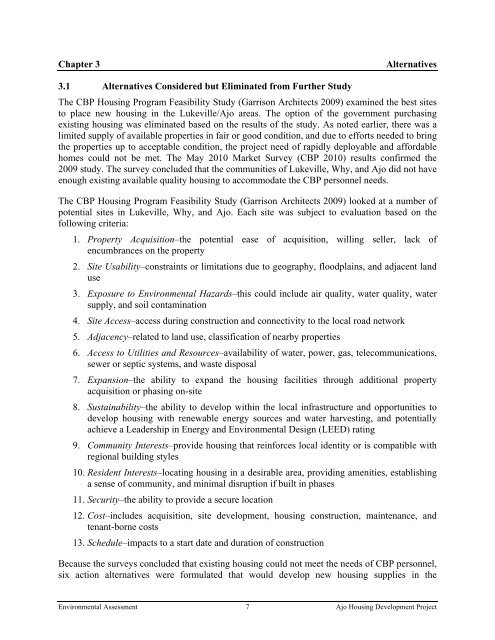US Customs and Border Protection Ajo Housing Development ... - GSA
US Customs and Border Protection Ajo Housing Development ... - GSA
US Customs and Border Protection Ajo Housing Development ... - GSA
Create successful ePaper yourself
Turn your PDF publications into a flip-book with our unique Google optimized e-Paper software.
Chapter 3<br />
Alternatives<br />
3.1 Alternatives Considered but Eliminated from Further Study<br />
The CBP <strong>Housing</strong> Program Feasibility Study (Garrison Architects 2009) examined the best sites<br />
to place new housing in the Lukeville/<strong>Ajo</strong> areas. The option of the government purchasing<br />
existing housing was eliminated based on the results of the study. As noted earlier, there was a<br />
limited supply of available properties in fair or good condition, <strong>and</strong> due to efforts needed to bring<br />
the properties up to acceptable condition, the project need of rapidly deployable <strong>and</strong> affordable<br />
homes could not be met. The May 2010 Market Survey (CBP 2010) results confirmed the<br />
2009 study. The survey concluded that the communities of Lukeville, Why, <strong>and</strong> <strong>Ajo</strong> did not have<br />
enough existing available quality housing to accommodate the CBP personnel needs.<br />
The CBP <strong>Housing</strong> Program Feasibility Study (Garrison Architects 2009) looked at a number of<br />
potential sites in Lukeville, Why, <strong>and</strong> <strong>Ajo</strong>. Each site was subject to evaluation based on the<br />
following criteria:<br />
1. Property Acquisition–the potential ease of acquisition, willing seller, lack of<br />
encumbrances on the property<br />
2. Site Usability–constraints or limitations due to geography, floodplains, <strong>and</strong> adjacent l<strong>and</strong><br />
use<br />
3. Exposure to Environmental Hazards–this could include air quality, water quality, water<br />
supply, <strong>and</strong> soil contamination<br />
4. Site Access–access during construction <strong>and</strong> connectivity to the local road network<br />
5. Adjacency–related to l<strong>and</strong> use, classification of nearby properties<br />
6. Access to Utilities <strong>and</strong> Resources–availability of water, power, gas, telecommunications,<br />
sewer or septic systems, <strong>and</strong> waste disposal<br />
7. Expansion–the ability to exp<strong>and</strong> the housing facilities through additional property<br />
acquisition or phasing on-site<br />
8. Sustainability–the ability to develop within the local infrastructure <strong>and</strong> opportunities to<br />
develop housing with renewable energy sources <strong>and</strong> water harvesting, <strong>and</strong> potentially<br />
achieve a Leadership in Energy <strong>and</strong> Environmental Design (LEED) rating<br />
9. Community Interests–provide housing that reinforces local identity or is compatible with<br />
regional building styles<br />
10. Resident Interests–locating housing in a desirable area, providing amenities, establishing<br />
a sense of community, <strong>and</strong> minimal disruption if built in phases<br />
11. Security–the ability to provide a secure location<br />
12. Cost–includes acquisition, site development, housing construction, maintenance, <strong>and</strong><br />
tenant-borne costs<br />
13. Schedule–impacts to a start date <strong>and</strong> duration of construction<br />
Because the surveys concluded that existing housing could not meet the needs of CBP personnel,<br />
six action alternatives were formulated that would develop new housing supplies in the<br />
Environmental Assessment 7 <strong>Ajo</strong> <strong>Housing</strong> <strong>Development</strong> Project
















